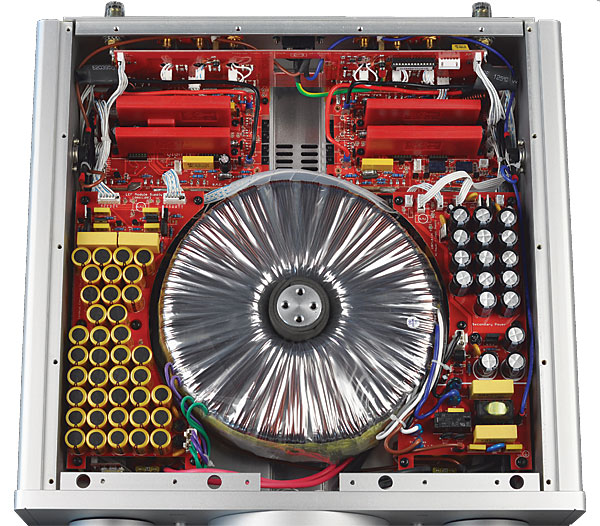| Columns Retired Columns & Blogs |
B.M.C. Audio Amplifier C1 integrated amplifier Page 2
The result, he claims, is an amplifier with exceptional drive and control abilities: ie, one that can drive speakers that present complex loads. With high linearity comes very low distortion, obviating the need for correction circuits: no global feedback.
When I asked if the Amp C1 used any feedback at all, he said there's a problem with using the term local feedback—but he assured me that a type of feedback was used in the Amp C1, otherwise it would produce "crazy gains."
Candeias then talked about the difference between a standard attenuator and what he's done in the Amp C1: "In a standard system, we start with a 'healthy' [sized] signal from a CD player or from a phono stage, where we first have to amplify it to reach a 'healthy' size, and then we chop it down to a small amount using the volume control to send it to the preamplifier stage, and then we route it to a power amplifier with a fixed gain to bring it up again. This doesn't really sound logical to me, and it's always 'lossy,' and everyone's trying to figure out how to minimize the loss."
Whereas a conventional amplifier has multiple voltage gain stages, an LEF amp has but one, not even a preamplifier. The amplifier can be "shorter." And if the gain stage is totally independent of the subsequent power stage, it's easy to set any desired amount of gain. Rather than a conventional attenuator ahead of a voltage amplification stage, Candeias's design changes its gain according to the desired volume. The input always delivers the full signal from the source. It's not attenuated. Candeias calls this Discrete Intelligent Gain Management (DIGM). It avoids unnecessarily high overall gain and additional amplifier stages, as well as the need to attenuate the input signal.
And that's why he doesn't call the Amp C1 an integrated amplifier. While the Amp C1 has switched inputs and you can adjust its output level in 66 1dB steps, it's hardly a traditional integrated amplifier with a preamplifier section and a typical resistor attenuator based volume control.

So instead of a standard resistor-based attenuator, the Amplifier C1 uses extremely linear, bipolar, class-A switches to change both gain and bandwidth with greater than 0.5% precision. The more you go down in level, the wider the amplifier's bandwidth.
The last of his innovations that Candeias told me about is something he calls current injection. Every amplifier stage in effect makes a copy of the original signal that's not as good as the original. The fewer copies, the better. Current injection generates the subsequent amplified voltage out of the original current, without making a copy. It's particularly useful in phono stages, since moving-coil cartridges are good current sources but produce weak voltages. All B.M.C. power amps have current-injection inputs that replace gain stages with current-to-voltage converters.
In short, B.M.C. amplifiers look and work like typical amplifiers, but what goes on inside them is anything but. Candeias claims that the LEF circuit produces class-A performance and high power output with close to class-A/B efficiency.
Of course, any idea or system has downsides and compromises. When I asked Candeias about this, he was candid in explaining these and how he's tried to work around them, but there's not enough space to go into all the details. He did say, however, that at maximum gain levels—where no one will ever go—the Amplifier C1's frequency response is "not so wide." But, he said, "That's it!"
Using the Amplifier C1
The Amplifier C1's innards may be unique, but I found its operation straightforward, and it includes some nice touches. The amp mutes on power-up; when it's ready to deliver a signal, the volume ramps up to a moderate level (an indicated "10" on the front-panel display). When you switch between inputs, the C1 automatically fades the level down, then up again to avoid noise and abrupt changes in level. Setting the amp to "00" is equivalent to muting it.
The peak-reading meter displays the Amp C1's power output in watts (for a 4 ohm speaker) and in dB relative to 1W. The instruction manual includes a chart for converting dB to power, but even so, the meter's red needles are somewhat difficult to read unless your face is only inches away.
The Amplifier C1 sat on the floor between my Wilson Audio MAXX 3 speakers, on a Symposium Ultra platform. Balanced Stealth Indra interconnects connected it to Simaudio's Moon Evolution 650D DAC–CD transport, and a length of single-ended ZenSati Seraphim to the Ypsilon VPS Phono preamplifier. Yes, the interconnects cost more than the electronics reviewed, but considering the lengths required, I figured, why not go with the best? Ditto the speaker cables: TARA Labs Omega and AudioQuest WEL Signature, both of which cost more than twice the Amp C1's price.
Innovative Sound?
On first hearing, what had sounded, as Carlos Candeias described it, like a truly innovative circuit design did not produce shocking or startling sound. Immediately obvious was that B.M.C. Audio's claim of "exceptional drive and control capabilities" was 100% true. It took me only a few seconds to hear that the Amplifier C1 had clamped on to the MAXX 3s' woofers and was conducting them with an iron fist.
The C1's deep, punchy, extended, well-controlled bass made it a king of rhythm'n'pace. It produced taut, fully extended, well-textured lows that rivaled in those regards the performance of far more expensive amplifiers, including darTZeel's NHB-458 monoblocks ($130,000/pair, review to come), which I'd been listening to when it was time to start reviewing the B.M.C. The Amp C1's bass wasn't as supple, nimble, or nuanced—but the darTZeel costs more than 16 times as much!
- Log in or register to post comments




































